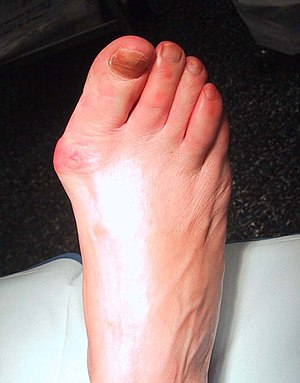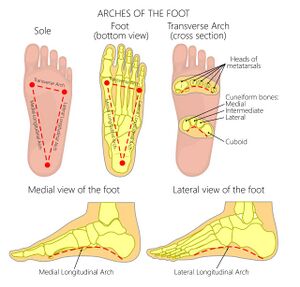The Ageing Foot
Original Editor - Ewa Jaraczewska based on the course by Helene Simpson
Top Contributors - Ewa Jaraczewska, Jess Bell and Kim Jackson
Introduction[edit | edit source]
Older adults can present with various foot problems, and the aetiology of these conditions is often multifactorial. However, the three major foot pathologies are pain, neuropathy, and deformities.[1] One in four older adults have foot pain.[2] This pain can affect normal walking and contribute to falling and functional disability in older adults.[3] Musculoskeletal pathologies and vascular and neurological disorders may cause foot pain in the older population.[4] The most common orthopaedic deformities in the elderly include hallux valgus, prominent metatarsal heads, and an abnormal medial arch structure.[3] Overall, foot deformities and other foot conditions are highly prevalent in adults aged over 65 years.[5] These conditions in older adults can be associated with frailty and decreased physical activity.[1]
Risk factors[edit | edit source]
The following are the risk factors for foot problems in older adults:
- Gender (women more frequently affected than men)[2][6]
- Obesity[1]
- Chronic conditions, including diabetes and osteoarthritis[1]
- Peripheral neuropathy[6]
- Neurological disorders (stroke, Parkinson's)[1]
- Lower extremity oedema (can be related to vascular or cardiac pathology)[6]
- Inappropriate footwear[1]
- Underlying geriatric syndromes and conditions[1]
Age-Related Changes in the Foot[edit | edit source]
Physiological changes[edit | edit source]
Skin[edit | edit source]
Weight-bearing activities place specific demands on the skin of the foot's plantar surface. The foot has certain features to accommodate these loads.[2] The epidermis is thicker in the foot compared to other parts of the body, the dermis is around 3mm thick and has adipose tissue that can resist sheer forces, and the fingerprint-like pattern of the epidermis helps to generate enough friction during walking.[2] However, all aspects of the skin change as a person ages. These changes affect not only the superficial skin, but also the local vascular response, thermoregulation, sensory perception, and injury response,[7] and they include:
- Flattening of the dermo-epidermal junction[2]
- Decreased contact between dermis and epidermis, which causes the skin to separate along this interface[8]
- Loss of elastin and collagen fibres in the dermis. The dermis becomes atrophic. There is a reduction of fibroblasts, and the collagen becomes disorganised.[8] The remaining collagen fibres become thicker and stiffer.[9]
- Limited ability by the dense collagen to recoil, which leads to increased compression and development of hyperkeratosis (corns and calluses)[10]
- Alteration in the plantar skin mechanical properties, leading to increased hardness[2] and dryness
- A reduction in density of sweat glands, which contributes to impaired thermoregulation[2][8]
- Loss of subcutaneous fat and decreased dermal vascularity, leading to poor thermoregulation[8]
- Reduced sensation to touch, pressure, and vibration due to decreased mechanoreceptors (Meissner and Pacini corpuscles)[8]
Overall, the thickening of the exterior layer of the skin and the presence of calluses may cause severe pain and disability, including plantar lesions. The best management strategies are custom-made orthotics, which support the medial arch and unload the metatarsal heads.[6]
Soft Tissue[edit | edit source]
Plantar soft tissue's role is to protect underlying blood vessels and nerves and to reduce the shear forces that occur while walking. Progressive stiffness is the immediate change in the foot's soft tissues related to ageing. It affects the tissue at the big toe, first, third, and fifth metatarsal heads, and the heel. [11] The metatarsal pad becomes slower to recover after being compressed. Similarly, the heel pad dissipates more energy when compressed[2], and the plantar fascia demonstrates less recoil due to stiffness. [12]The consequences of the soft tissue ageing process are:[2]
- Range of motion reduction (especially in ankle dorsiflexion)
- Achilles tendon complaints
- Changes in gait pattern: more pull-off vs pushing off, less propulsion
- Increased risk of falls
Range of Motion[edit | edit source]
The ageing process affects joint physiology leading to joint stiffness. The changes include:[2]
- Reduction in the water content of the cartilage
- Reduction in the synovial fluid volume and the proteoglycans
- Bonding of the collagen fibres.
A decrease in ankle dorsiflexion and subtalar joint inversion-eversion range in the elderly contributes to their ability to perform dynamic tasks, maintain a static standing balance, and perform functional activities.[13]
Muscles Strength[edit | edit source]
Progressive changes in skeletal muscle mass (sarcopenia), metabolism and functional capacity are typical in the ageing population.[14] A reduction in the size and number of muscle fibres characterises foot muscles in the elderly. Large, slow-twitch motor units develop and type II fibres become denervated. These occurrences indicate the presence of age-related atrophy, which can be exacerbated by the long-term wearing of poorly fitting footwear. [2]In addition, the consequences of foot muscles atrophy in the elderly include:[2]
- Decreased ankle plantar flexor strength (difficulties in rising onto the toes)
- Toe plantar flexor weakness negatively affects the grasping function of the toes during weight-bearing activities (impaired static and dynamic balance and functional ability, increased risk of falls)[15]
- Development of toe deformities, with hallux valgus and lesser toe deformities
Biomechanical Changes[edit | edit source]
Age-related changes in soft tissue, range of motion, and muscle strength lead to the following biomechanical changes:[2]
- The lowering of the medial longitudinal arch
- Reduced a midfoot and metatarsal mobility
- Flatter and more dynamically pronated feet
- Planus foot posture
- Less plantarflexed calcaneus at toe-off gait phase
- Less propulsive gait pattern
Physiotherapy Intervention[edit | edit source]
General Principles[edit | edit source]
- Do not focus just on foot.
- Assess the kinetic chain: look at the posture, weight distribution, and centre of mass distribution.
- Offer stretching and strengthening program.
- Use manual techniques to reduce tissue stiffness.
- Stimulate the plantar sensors.
- Assess the footwear.
- Be careful when choosing orthotics for medial arch support: do not make the foot stiffer.
Therapeutic Interventions[edit | edit source]
Manual techniques: mobilisation of the stiff foot and stimulation of the plantar sensors to increase proprioception and improve balance.
Stretching: heel cord stretching and calf muscles stretching to reduce pressure on the forefoot.
Strengthening: toe strengthening exercises to improve the strength of the intrinsic muscles of the foot, increase the stability of the arch, improve the toe-off phase of gait and balance during ambulation.
Footwear assessment and modification: O'Rourke et al.[16] found that older adults often wear incorrectly fitting shoes or shoes with unsafe features, like slippers. [16]Slippers demand the grabbing function of the toes, which contributes more to the drop of the medial arch and the development of the hammer toes. [6] Proper shoes should be soft to cushion the foot and supportive to prevent the foot from collapsing.
Orthotics: collaboration with an orthotist to make a custom-made orthosis that supports the medial arch without increasing foot stiffness. The proper orthotics should allow for increased shock absorption capacity in the foot.
Resources[edit | edit source]
- Frailty as an Outcome Predictor After Ankle Fractures: Where Are We Now?
- Does the shoe really fit? Characterising ill-fitting footwear among community-dwelling older adults attending geriatric services: an observational cross-sectional study.
References[edit | edit source]
- ↑ 1.0 1.1 1.2 1.3 1.4 1.5 1.6 Muchna A, Najafi B, Wendel CS, Schwenk M, Armstrong DG, Mohler J. Foot Problems in Older Adults Associations with Incident Falls, Frailty Syndrome, and Sensor-Derived Gait, Balance, and Physical Activity Measures. J Am Podiatr Med Assoc. 2018 Mar;108(2):126-139. doi: 10.7547/15-186. Epub 2017 Aug 30.
- ↑ 2.00 2.01 2.02 2.03 2.04 2.05 2.06 2.07 2.08 2.09 2.10 2.11 2.12 Menz HB. Biomechanics of the ageing foot and ankle: a mini-review. Gerontology. 2015;61(4):381-8.
- ↑ 3.0 3.1 Zhang B, Lu Q. A current review of foot disorder and plantar pressure alternation in the elderly. Physical Activity and Health. 2020 Sep 2;4(1).
- ↑ Oh-Park M, Kirschner J, Abdelshahed D, Kim DDJ. Painful Foot Disorders in the Geriatric Population: A Narrative Review. Am J Phys Med Rehabil. 2019 Sep;98(9):811-819.
- ↑ Helfand AE. Foot problems in older patients: a focused podogeriatric assessment study in ambulatory care. J Am Podiatr Med Assoc. 2004 May-Jun;94(3):293-304.
- ↑ 6.0 6.1 6.2 6.3 6.4 Simpson H. The Ageing Foot Course. Plus 2022
- ↑ Fenske NA, Lober CW. Structural and functional changes of normal ageing skin. J Am Acad Dermatol. 1986 Oct;15(4 Pt 1):571-85.
- ↑ 8.0 8.1 8.2 8.3 8.4 Levine JM. Clinical aspects of ageing skin: Considerations for the wound care practitioner. Advances in skin & wound care. 2020 Jan 1;33(1):12-9.
- ↑ Smith L. Histopathologic characteristics and ultrastructure of ageing skin. Cutis. 1989 May;43(5):414-24.
- ↑ Periyasamy R, Anand S, Ammini AC. The effect of ageing on the hardness of foot sole skin: a preliminary study. Foot (Edinb). 2012 Jun;22(2):95-9.
- ↑ Kwan RL, Zheng YP, Cheing GL. The effect of ageing on the biomechanical properties of plantar soft tissues. Clin Biomech (Bristol, Avon). 2010 Jul;25(6):601-5.
- ↑ Jha DK, Wongkaewpotong J, Chuckpaiwong B. Effect of Age and BMI on Sonographic Findings of Plantar Fascia. J Foot Ankle Surg. 2022 May 23:S1067-2516(22)00157-0
- ↑ Hernández-Guillén D, Tolsada-Velasco C, Roig-Casasús S, Costa-Moreno E, Borja-de-Fuentes I, Blasco JM. Association ankle function and balance in community-dwelling older adults. PloS one. 2021 Mar 4;16(3):e0247885.
- ↑ Shur NF, Creedon L, Skirrow S, Atherton PJ, MacDonald IA, Lund J, Greenhaff PL. Age-related changes in muscle architecture and metabolism in humans: The potential contribution of physical inactivity to age-related functional decline. Ageing Research Reviews. 2021 Jul 1;68:101344.
- ↑ Yong-Wook K, Oh-Yun K, Heon-Seock C, Jong-Hyuck W, Chung-Hwi Y, Tae-Ho K. Comparison of Toe Plantar Flexors Strength and Balancing Ability between Elderly Fallers and Non-fallers. Journal of Physical Therapy Science 2011; 23 (1): 127-132
- ↑ 16.0 16.1 O’Rourke B, Walsh ME, Brophy R, Vallely S, Murphy N, Conroy B, Cunningham C, Horgan NF. Does the shoe really fit? Characterising ill-fitting footwear among community-dwelling older adults attending geriatric services: an observational cross-sectional study. BMC geriatrics. 2020 Dec;20(1):1-8.
- ↑ Dr Sinha Housecall Doctors. How Aging Affects Your Feet Available from: https://www.youtube.com/watch?v=j_819z3ILH0 [last accessed 17/09/2022]








